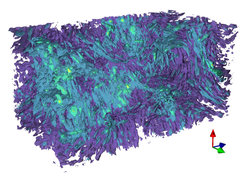Max-Planck-Princeton partnership in fusion research confirmed
Investigation of plasmas in astrophysics and fusion research / funding for another two to five years
The scientific performance of Max-Planck-Princeton Center for Plasma Physics, established in 2012 by the Max Planck Society and Princeton University, USA, has been evaluated and awarded top grade. The Max Planck Society has now decided to continue its support for another two to maximum five years with 250,000 euros annually. The center’s objective is to link up the hitherto less coordinated research on fusion, laboratory and space plasmas and utilise synergies.

The center’s partners in fusion research are Max Planck Institute for Plasma Physics (IPP) at Garching and Greifswald and Princeton Plasma Physics Laboratory (PPPL) in the USA. Plasmas in astrophysics are being investigated at Max Planck Institute for Solar System Research in Göttingen and of Astrophysics in Garching and at the Faculty of Astrophysics of Princeton University. Primarily through exchange of scientists, particularly junior scientists, computer codes have been jointly developed in the past five years and experimentation has been pursued on the devices MRX at Princeton, Vineta at Greifswald and ASDEX Upgrade at Garching. “For the evaluation the center presented a total of 150 publications, accounting for significant progress in central areas of plasma physics and astrophysics”, states Professor Per Helander, head of IPP’s Stellarator Theory division and, alongside Professor Amitava Bhattacharjee from PPPL, Deputy Director of Max-Planck-Princeton Center since 2017.
For example, the old question in astrophysics why solar wind is much hotter than the sun’s surface can now be treated with a computer code developed to describe turbulence in fusion plasmas. This enabled plasma theoreticians from IPP along with US colleagues to investigate in detail the heating mechanism in solar wind plasma – with hitherto unattained accuracy – and compare their results with space probe measurements.

Another puzzle whose solution has been approached at Max-Planck-Princeton Center: Why is it that in outer space and in the laboratory magnetic reconnection, i.e. rupture and relinking of magnetic field lines, is much faster than theory predicts? Whether solar corona or fusion plasma, the rearrangement of the field lines is always accompanied by fast conversion of magnetic energy to thermal and kinetic energy of plasma particles. Physicists from Max Planck Institute for Solar System Research and from the University of Princeton have described a fast mechanism that could describe the observations in the solar corona: formation of unstable plasmoids. Also the sawtooth instability in fusion plasmas, i.e. continual ejection of particles from the plasma core, derives from instantaneous reconnection of magnetic field lines. In the framework of the Max-Planck-Princeton cooperation IPP scientists have now come up with the first realistic simulation that can explain the superfast velocity.
Last but not least, a new theory ansatz for calculating magnetic equilibria, first developed at Princeton, led to a very fast computer code. With the new algorithm, equilibrium calculations for the complex magnetic fields of future stellarator fusion devices no longer take months, but just a few minutes.
“As hoped, the center has created new cooperations and built sturdy bridges, on the one hand between research on plasmas in fusion devices, in the laboratory and in outer space, and on the other hand between US and German plasma physicists”, as IPP’s Scientific Director Professor Sibylle Günter sums up the past five years of Max-Planck-Princeton Center. Along with Professor Stewart Prager of PPPL she is one of the two Co-directors of the center. The successful cooperation has meanwhile attracted further partners. In July 2017, a Memorandum of Understanding for admission of Japan’s National Institutes of Natural Sciences was signed: “We look forward to the next years of joint research”, states Sibylle Günter, “made possible by the present confirmation by the Max Planck Society”.
Isabella Milch

